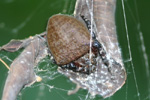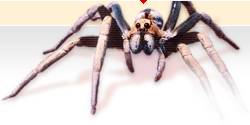
Orb-weaving Spiders
Araneidae Simon 1895
(compiled by V.W. Framenau)
Identification
 opens in new window
opens in new window
from Christmas Island
The eyes of the spiders in the family Araneidae are oriented in two rows. The lateral eyes are contiguous and widely separated from the median eyes, so that they appear on the lateral margin when viewed from above. The legs are relatively stout and strongly spined. When at rest, the spiders flex their legs back above the body. The male pedipalp is generally large and complex and the epigyne may have a distinct scape.
Araneidae construct an orb-web with a sticky spiral, however, numerous reductions and modifications are possible.
Biology
Due to their conspicuous webs, the common orb-weavers of the spider family Araneidae are among the best-known group of spiders, and with some 2,800 species in 163 genera it is one of the largest spider families world-wide.
More than 900 scientific papers have been published on araneids since the turn of the century and members of this family have been the subject of considerable phylogenetic and evolutionary research (Scharff and Coddington 1997, and references therein). These studies investigated some classical evolutionary problems, e.g. the evolution of web forms (including the form and function of web stabilimenta), but also address spider mating behaviour (e.g. sperm competition and sexual size dimorphism) and foraging tactics. Araneid spiders have also been the focus of considerable applied research investigations, e.g. in pest control, pharmacology, venom research and the mechanical properties of silk.
Araneidae in Australasia
Australia
Despite their omnipresence, diversity and well-studied behaviour, Araneidae belong to one of the taxonomically least-studied spider groups in Australia. There is no current synthesis of Australian Araneidae or any of its subfamilies and the family is not listed on the Australian Faunal Directory (ABIF 2004). The single comprehensive revisionary work on Australasian araneids deals with the genera Argiope, Gea, and Neogea (Levi 1983; Bull. Mus. Comp. Zool. 150: 247-338.). In Australia, the family is represented by ca. 230 described species in ca. 30 genera. The genus Araneus currently contains some 100 Australian species but is thought not to occur in this country. Some smaller genera seem to be endemic to Australia, such as Dolophones (currently 16 species) and Paraplectanoides (3 species).
Valerie Todd Davies (1988; Mem. Qd Mus. 25: 273-332) published a key to the currently recognized orb-weaving spiders of Australia, which also includes other spider families, such as Uloboridae, Deinopidae, Tetragnathidae, Theridiosomatidae, Mysmenidae, Symphytognathidae and Anapidae.
Volker Framenau (Western Australian Museum) and Nikolaj Scharff (University of Copenhagen) have received funding through the Australian Biological Resource Study (ABRS) to study the taxonomy and systematics of one subfamily of the Australian Araneidae, the Araneinae, from end 2005 to end 2008.
New Zealand
Approximately 35 species of Araneidae in 13 genera are known from New Zealand. Court and Forster (1988; Araneidae-Araneinae. In: The Spiders of New Zealand. Part VI. Otago Museum Bulletin No. 6, Dunedin, pp. 68-124) revised the Araneinae and recognised a large number of synonymies in this group of conspicuous orb-weavers. They also recognised a number of endemic New Zealand genera, such as Zealaranea, Colaranea, Cryptaranea, and Novaranea.
South-east Asia
There is currently no comprehensive treatment on the Araneidae of South East Asia, but information on some species can be found in Murphy & Murphy (2000) ‘An Introduction to the spiders of South East Asia’, Malaysian Nature Society (United Sengalor Press Sdn. Bhd.).

